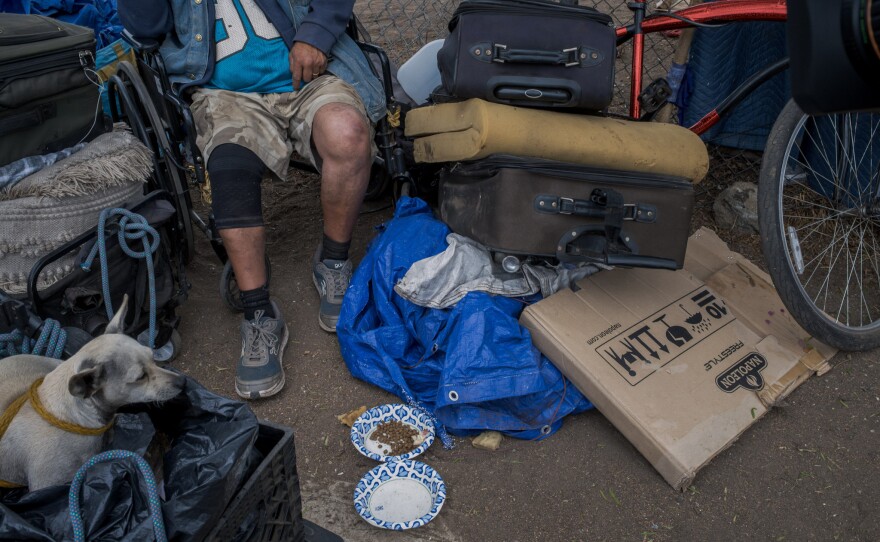City crews are cleaning up homeless encampments in areas of downtown San Diego that were previously out of reach.
The city has prohibited tent camping on sidewalks and other public property since 2023. After the city began enforcing the ordinance, some unhoused residents found they could camp for weeks or even months at a time if they moved to state property along freeway onramps and under overpasses.
That has meant city outreach workers have had less contact with people who might be open to accepting help, said Franklin Coopersmith, the city’s deputy director of environmental services.
“If someone is left somewhere for months at a time, they build an area, they build a community,” he said. “It's really hard to get people to say, ‘Hey, would you like to drop all of that right now and come to a place that you don't know?’ That's a very hard thing to get someone to do that's been out for a long time.”
A new agreement with the California Department of Transportation (Caltrans) is giving the city more access to those encampments.
For the next year, the state will reimburse the city up to $400,000 for clearing encampments along five miles of freeway through downtown, Little Italy, Sherman Heights, East Village and Barrio Logan.
“Rather than doing the whole San Diego area and having to contribute so many resources that we truly don't have to cover that many miles of freeway, we knew that we could at least commit to our hardest areas, which were downtown,” he said.
So far, San Diego has cleared 57 encampments and more than 88,000 pounds of trash along freeways, according to the city. Sixteen people have accepted offers of shelter and support services.
“I would say it is a low percentage at this point that are saying yes,” Coopersmith said.
On a recent Friday, city crews cleaned up trash and belongings left behind by campers on a patch of dirt next to an onramp to Interstate 5.
Juan Carlos Rivera, 61, declined the offer of shelter.
“A lot of us got a lot of stuff we're not willing to give up yet,” he said.
He’s been homeless for a year and a half, he said. He has arthritis in his knees and uses a wheelchair. He’s lost many of his belongings.
“Right now, I don’t even have a tent,” he said. “Somebody stole it.”

Father Joe’s Villages street health team also helps people living in encampments, such as Rivera. Their patients don’t know where to go, and the community is tense, said Jenni Wilkens, who manages the team.
“Shelter beds are not readily accessible,” she said. “It's not like they can just decide to move into shelter if there's no bed available.”
The city’s shelter system lost hundreds of beds in the last year. Casey Snell, who oversees the San Diego Housing Commission’s homelessness programs, told the board in July that in the previous year, just 12% of people referred to shelter got beds. At the same time, the need increased.
“In a year where we lost a lot of beds, we saw the need increase by 15% over the year,” Snell told the board. “Sorry it’s not better news.”
San Diego is just one city working with Caltrans to remove encampments near freeways. Riverside announced a two-year agreement with Caltrans earlier this month. Chula Vista is also pursuing one.
San Diego has also requested federal funding to operate an 88-bed shelter and expand the Safe Sleeping Program.
In the meantime, its city workers are making their rounds, picking up trash and offering help to people living on the fringes. Coopersmith said he knew people would return to the area they’d just cleaned up.
“But that's why we're trying to come on a regular basis, make those contact points, let people know we're here,” he said. “We know it's going to take sometimes two, three, four times before people actually say yes.”





